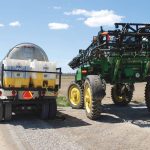A Washington State scientist has concluded that genetically modified crops have increased the use of pesticides over the last 15 years, contrary to industry claims.
Charles Benbrook, a research professor at the university’s Centre for Sustaining Agriculture and Natural Resources, reviewed U.S. government data and determined that the advent of GM crops increased the use of pesticides by 183 million kilograms in the United States between 1996 and 2011.
The figures represent a seven percent increase in pesticide use over the 15-year period, compared to a hypothetical scenario in which growers didn’t have access to herbicide tolerant crops or B.t. corn and B.t. cotton.
Read Also

Extreme rain increases as planet warms
In this issue, we are going to wrap up our look at extreme rainfall by examining the different weather patterns that tend to be associated with these rainfall events.
Benbrook’s study, published last year in Environmental Sciences Europe, focused solely on corn, soybeans and cotton, the three primary GM crops in the U.S.
It is an update of previous research on the same topic by Benbrook, who is chief scientist for the Organic Center, a U.S. institution aimed at converting agriculture to organic practices.
Benbrook used publicly available data from the U.S. Department of Agriculture and the Environmental Protection Agency to develop the figures for his research.
There are gaps in the data because the USDA hasn’t surveyed pesticide use on soybeans since 2006, but Benbrook is confident herbicide use has increased substantially since the mid-1990s, when GM crops were first introduced.
“I think it’s widely accepted that herbicide use has gone up fairly dramatically on herbicide tolerant acres in the U.S.,” he said.
Based on his data, U.S farmers planted 550 million acres of herbicide tolerant corn, soybeans and cotton between 1996 and 2011. Most of the varieties were Roundup Ready.
For soybeans, the USDA reported herbicide applications of .53 kg per acre in 1996 and .64 kg per acre in 2006.
In cotton, herbicide use increased from .85 kg per acre in 1996 to 1.22 kg per acre in 2010.
In corn, herbicide use has actually fallen, going from 1.21 kg per acre in 1996 to 1.03 kg per acre in 2010.
In total, Benbrook estimated that herbicide tolerant technology caused a 239 million kg increase in herbicide use from 1996 to 2011.
The data undermines crop science industry claims that GM crops lessen the need for herbicides, said David Mortensen, a weed science professor at Penn State.
“It never really made sense to me… that herbicide resistant crops would reduce herbicide use,” he said.
“You’re inserting a trait that’s (allowing) you to not use some other things, but you’re going to have to use this one thing a lot.”
Benbrook conceded in his paper that glyphosate is a relatively benign product. Its use has increased since the advent of herbicide tolerant crops, but it has displaced more hazardous herbicides used before the mid-1990s.
Nonetheless, he said the real concern is the selection of weeds resistant to the chemical, which has forced U.S. farmers to apply other herbicides in addition to glyphosate.
“Ten or 20 years down the round, when Roundup is no longer an effective herbicide in most of North America, farmers are going to ask some very tough questions. How could’ve we allowed this incredibly valuable herbicide to be burnt up in less than a generation?”
However, Benbrook is more positive about B.t. traits. U.S. data shows the technology has reduced the amount of pesticides applied to corn and cotton crops by 56 million kg from 1996 to 2011.
As for stacked traits, in which crop science companies plan to release crop varieties that are tolerant of dicamba, 2,4-D and glyphosate, Benbrook is worried the new technology will cause a spike in herbicide use.
Mortensen estimated in a paper published in the American Institute of Biological Sciences that stacked traits would double the amount of herbicide applied to soybeans, assuming that 91 percent of all soybean acres would be tolerant of a combination of dicamba, 2,4-D and glyphosate by 2024.
“Our estimates are a two to threefold increase of herbicide use on soybeans,” he said, adding few scientists have challenged the figures.
“We’ve had a lot of people take shots at the paper … but I haven’t heard anyone actually argue with me about the numbers on the herbicide use part.”
Neil Harker, an Agriculture Canada research scientist in Lacombe, Alta., agreed that stacked technology would increase overall herbicide use.
“You put down the first part of the stack, the glyphosate as a base treatment, and then you’ll just add in 2,4-D,” he said.
Benbrook is concerned about a considerable increase in dicamba and 2,4-D because the herbicides may move into the atmosphere and drift toward non-target plants, such as commercial fruits and vegetables.
“These are plant growth regulators that disrupt the reproductive cycle of plants…. This is going to become a huge problem,” he said.
“By genetically engineering corn to make it possible to apply 2,4-D all the way through July, we’re going to have farmers in the Midwest applying in July when specialty crops, backyard gardens and trees are fruiting.”














